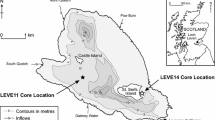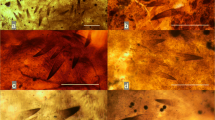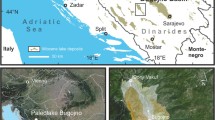Abstract
As part of the international cooperative Baikal Drilling Project, siliceous microfossil assemblage succession was analyzed in two short (∼ 30-cm) sediment cores from Lake Baikal. One core was recovered from the north basin (Core 324, 55°15′N, 109°30′E), a second from between the central and southern basins (Core 316, 52°28′N, 106°5′E). The northern core had higher amounts of biogenic silica (40 g SiO2 per 100 g dry weight sediment) compared to the southern core, and increased deposition in the more recent sediments. Weight percent biogenic silica was lower in the southern core, ranging from approximately 20–30 g SiO2 per 100 g dry weight sediment throughout the entire core. Trends in absolute microfossil abundance mirror those of biogenic silica, with generally greater abundance in the northern core (86–275×106 microfossils g−1 dry sediment) compared to the southern core (94–163×106 microfossils g−1 dry sediment).
Cluster analyses using relative abundance of the dominant diatom and chrysophyte taxa revealed four zones of microfossil succession in each core. Microfossil assemblage succession in the north basin may be reflecting shifts in nutrient supply and cycling driven by climatic changes. The most recent sediments in the northern basin (Zone 1,c. 1890's–1991 A.D.) were characterized by an increased abundance ofAulacoseira baicalensis andAulacoseira ‘spore’. Zone 3 (c. 1630's–1830's A.D.) was dominated by the endemicCyclotella spp. and reduced abundance of theAulacoseira spp. Zone 3 corresponds approximately to the Little Ice Age, a cooler climatic period. The microfossil assemblages between Zones 1 and 3 (Zone 2,c. 1830's–1890's A.D.) and below Zone 3 (Zone 4,c. 830's–1430's A.D.) are similar to one another suggesting they represent transitional intervals between warm and cold periods. Southern basin sediments record similar changes in the endemic taxa. However, the increased abundance of non-endemic planktonic taxa (e.g.Stephanodiscus binderanus, Synedra acus, Cyclostephanos dubius) during two periods in recent history (post World War II and late 1700's) suggests evidence for anthropogenic induced changes in southern Lake Baikal.
Similar content being viewed by others
References
Battarbee, R. W., 1973. A new method for estimating absolute microfossil numbers with special reference to diatoms. Limnol. Oceanogr. 18: 647–653.
Belt, D., 1992. The World's Great Lake. National Geographic 181: 2–39.
Bondarenko, N. A., N. E. Guselnikova, S. S. Vorobyeva & N. F. Logacheva, 1993. Species composition of planktonic diatom algae of Lake Baikal and biology of dominant species. In Fifth Workshop on Diatom Algae: Diatom algae as indicators of the changes of climate and environment. Russian Academy of Sciences, Siberian Division, Irkutsk: 72–75.
Bradbury, J. P. & K. V. Dieterich-Rurup, 1993. Holocene diatom paleolimnology of Elk Lake, Minnesota. In J. P. Bradbury & W. E. Dean (eds), Elk Lake, Minnesota: evidence for rapid climate change in the North-Central United States. Geol. Soc. Amer. Spec. Paper No. 276. Geol. Soc. Amer., Boulder, Colorado: 215–237.
Bradbury, J. P., Ye. V. Bezrukova, G. P. Chernyaeva, S. M. Colman, G. Khursevich, J. W. King & Ye. E. Likoshway, 1994. A synthesis of post-glacial diatom records from Lake Baikal. J. Paleolim. 10: 213–252.
Carney, H., 1982. Algal dynamics and trophic interactions in the recent history of Frains Lake, Michigan. Ecology 63: 1814–1826.
Chernyaeva, G. P., 1970. Diatoms in the bottom sediments of northern Lake Baikal. In Bottom Deposits of Baikal. Academy of Sciences, Moscow: 144–160. (in Russian)
Conley, D. J. & C. L. Schelske, 1993. Potential role of sponge spicules in influencing the silicon biogeochemistry of Florida lakes. Can. J. Fish. aquat. Sci. 50: 296–302.
Edgington, D. N., J. V. Klump, J. A. Robbins, Y. S. Kusner, V. D. Pampura & I. V. Sandimirov, 1991. Sedimentation rates, residence times and radionuclide inventories in Lake Baikal from137Cs and210Pb in sediment cores. Nature 350: 601–604.
Eggimen, D. W., F. T. Manheim & P. R. Betzer, 1980. Dissolution and analysis of amorphous silica in marine sediments. J. sed. Petrol. 50: 215–225.
Flower, R. J., 1993. A taxonomic re-evaluation of endemicCyclotella taxa in Lake Baikal, Siberia. Nova Hedwigia Beih. 106: 203–220.
Foged, N., 1993. Some diatoms from Siberia especially from Lake Baikal. Diatom Research 8: 231–279.
Fritz, S. C., S. Juggins, R. W. Battarbee & D. R. Engstrom, 1991. Reconstruction of past changes in salinity and climate using a diatom-based transfer function. Nature 352: 706–708.
Galazii, G., 1991. Lake Baikal reprieved. Endeavour, New Series 15: 13–17.
Genkal, S. I. & G. I. Popovskaya, 1991. New data on the frustule morphology ofAulacoseira islandica (Bacillariophyta). Diatom Research 6: 255–266.
Granina, L. Z., M. A. Grachev, E. B. Karabanov, V. M. Kuptsov, M. K. Shimaraeva & D. F. Williams, 1993. Accumulation of biogenic silica in bottom sediments of Baikal. Russian Geology and Geophysics 34: 126–135.
Khotinskiy, N. A., 1984. Holocene climatic change. In Velichko, A. A. (ed.), Late Quaternary Environments of the Soviet Union. University of Minnesota Press, Minneapolis: 305–309.
Khursevich, G. K., 1989. Species Atlas.Stephanodiscus andCyclostephanos (Bacillariophyta) from Upper Cenozoic sediments, USSR. Science and Techniques, Minsk, 86 pp, 80 pl. (in Russian)
Kociolek, J. P. & E. F. Stoermer, 1988. Taxonomy and systematic position of theGomphoneis quadripunctata species complex. Diatom Research 3: 95–108.
Kozhov, M. M., 1963. Lake Baikal and its Life. Dr W. Junk Publishers, The Hague, 344 pp.
Kozhova, O. M., N. A. Shastina & G. S. Kaplina, 1982. Size characteristics ofMelosira islandica ssp.helvetica O. Müll. from Lake Baikal. Hydrobiological J. 18: 6–10.
Kuzmin, M. I., D. F. Williams, N. A. Logachev, S. Colman, B. N. Khakhaev, T. Kawai, P. Hearn, Sh. Horie, L. A. Pevzner, A. A. Bukharov & V. A. Fialkov, 1993. The Barkal Drilling Project: Scientific objectives and recent results. Russian Geology and Geophysics 34: 3–11.
Lake Baikal Paleoclimate Project Members, 1992. Initial results of U.S.-Soviet paleoclimate study of Lake Baikal. EOS, Trans. am. geophys. Union 73: 457–462.
Leinen, M., 1977. A normative calculation technique for determining opal in deep-sea sediments. Geoch. Cosmoch. Acta 41: 671–676.
Likhoshway, Ye., T. Nikiteeva, G. Pomazkina & Ye. Meleshko, 1993. Fossil diatom algae of Lake Baikal. In Fifth Workshop on Diatom Algae: Diatom algae as indicators of the changes of climate and environment. Russian Academy of Sciences, Siberian Division, Irkutsk: 95–98.
Lorefice, G. J. & M. Munawar, 1974. The abundance of diatoms in the southwestern nearshore region of Lake Ontario during the spring thermal bar period. Proc. 17th Conf. Great Lakes Res. 1974: 619–628.
Lund, J. W. G., 1966. The role of the turbulence in the seasonal cycle of some freshwater species ofMelosira. Bot. Zh. 51: 176–187. (in Russian)
Lydolph, P. E., 1977. Climates of the Soviet Union. World Survey of Climatology; Vol. 7. Elsevier Scientific Pub. Co., Amsterdam, 443 pp.
Maatela, P., J. Paasivirta, M. A. Grachev & E. B. Karabanov, 1990. Organic chlorine compounds in lake sediments. V. Bottom of Baikal near a pulp mill. Chemosphere 21: 1381–1384.
Makarova, I. V. & G. V. Pomazkina, 1992.Stephanodiscus inconspicuus. Algologia 2: 84–86. (in Russian)
Mortlock, R. A. & P. N. Froelich, 1989. A simple method for the rapid determination of biogenic:opal in pelagic marine sediments. Deep Sea Res. 36: 1415–1426.
Peck, J. A., J. W. King, S. M. Colman & V. A. Kravchinsky, 1994. A rock-magnetic record from Lake Baikal, Siberia: Evidence for Late Quaternary climate change. Earth Plan. Sci. Lett. 122: 221–238.
Pilskaln, C. H. & J. Paduan, 1992. Laboratory techniques for the handling and geochemical analysis of water column particulate and surface sediment samples. MBARI Tech. Rept. No. 92–9, 22 pp.
Popovskaya, G. I., 1991. Phytoplankton of Lake Baikal and its long-term changes (1958–1990). Dissertation Abstract: Academy of Sciences, Siberian Division, Central Siberian Botanical Garden, Novosibirsk, 32 pp. (in Russian)
Popovskaya, G., 1993. Planktonic diatom algae of Lake Baikal and their long-term monitoring. In Fifth Workshop on Diatom Algae: Diatom algae as indicators of the changes of climate and environment. Russian Academy of Sciences, Siberian Division, Irkutsk: 114–116.
Riasanovsky, N. V., 1984. A History of Russia, 4th Ed. Oxford University Press, New York, 695 pp.
Shimaraev, M. N., N. G. Granin & A. A. Zhdanov, 1993. Deep ventilation of Lake Baikal waters due to spring thermal bars. Limnol. Oceanogr. 38: 1068–1072.
Skvortzow, B. W., 1937. Bottom diatoms from Olhon Gate of Baikal Lake, Siberia. Philipp. J. Sci. 62: 293–377.
Skvortzow, B. W. & C. I. Meyer, 1928. A contribution to the diatoms of Baikal Lake. Proc. Sungaree River Biological Station. 1: 1–55.
Smol, J. P., 1988. Paleoclimate proxy data from freshwater arctic diatoms. Verh. int. Ver. Limnol. 23: 837–844.
Stoermer, E. F. & J. J. Yang, 1969. Plankton diatom assemblages in Lake Michigan. Univ. of Michigan, Ann Arbor, Michigan, Great Lakes Research Division Special Rep. No. 47, 168 pp.
Stoermer, E. F., R. G. Kreis & L. Sicko-Goad, 1981. A systematic, quantitative, and ecological comparison ofMelosira islandica O. Müll. withM. granulata (Ehr.) Ralfs from the Laurentian Great Lakes. J. Great Lakes Res. 7: 345–356.
Stoermer, E. F., J. A. Wolin, C. L. Schelske & D. J. Conley, 1985a. Postsettlement diatom succession in the Bay of Quinte, Lake Ontario. Can. J. Fish. aquat. Sci. 42: 754–767.
Stoermer, E. F., J. A. Wolin, C. L. Schelske & D. J. Conley, 1985b. An assessment of ecological changes during the recent history of Lake Ontario based on siliceous algal microfossils preserved in the sediments. J. Phycol. 21: 257–276.
Stoermer, E. F., J. P. Kociolek, C. L. Schelske & D. J. Conley, 1985c. Siliceous microfossil succession in the recent history of Lake Superior. Proc. Acad. nat. Sci. Philad. 137: 106–118.
Stoermer E. F., Q. Yu-zao & T. B. Ladewski, 1986. A quantitative investigation of shape variation inDidymosphenia (Lyngbye) M. Schmidt (Bacillariophyta). Phycologia 25: 494–502.
Stoermer, E. F., C. L. Schelske & J. A. Wolin, 1990. Siliceous microfossil succession in the sediments of McLeod Bay, Great Slave Lake, Northwest Territories. Can. J. Fish. aquat. Sci. 47: 1865–1874.
Stoermer, E. F., J. A. Wolin & C. L. Schelske, 1993. Paleolimnological comparison of the Laurentian Great Lakes based on diatoms. Limnol. Oceanogr. 38: 1311–1316.
Stoermer, E.F., M. B. Edlund, C. H. Pilskaln & C. L. Schelske, 1995. Siliceous microfossil distribution in the surficial sediments of Lake Baikal. J. Paleolim. (in press).
Weiss, R. F., E. C. Carmack & V. M. Koropalov, 1991. Deep-water renewal and biological production in Lake Baikal. Nature 349: 665–669.
Wilkinson, L., 1989. SYSTAT: The System for Statistics. SYSTAT, Inc., Evanston, IL, 638 pp.
Williams, D. F., L. Qui, E. Karabanov & A. Gvozdkov, 1993. Geochemical indicators of productivity and sources of organic matter in surficial sediments of Lake Baikal. Russian Geology and Geophysics 34: 111–125.
Author information
Authors and Affiliations
Rights and permissions
About this article
Cite this article
Edlund, M.B., Stoermer, E.F. & Pilskaln, C.H. Siliceous microfossil succession in the recent history of two basins in Lake Baikal, Siberia. J Paleolimnol 14, 165–184 (1995). https://doi.org/10.1007/BF00735480
Received:
Accepted:
Issue Date:
DOI: https://doi.org/10.1007/BF00735480




